
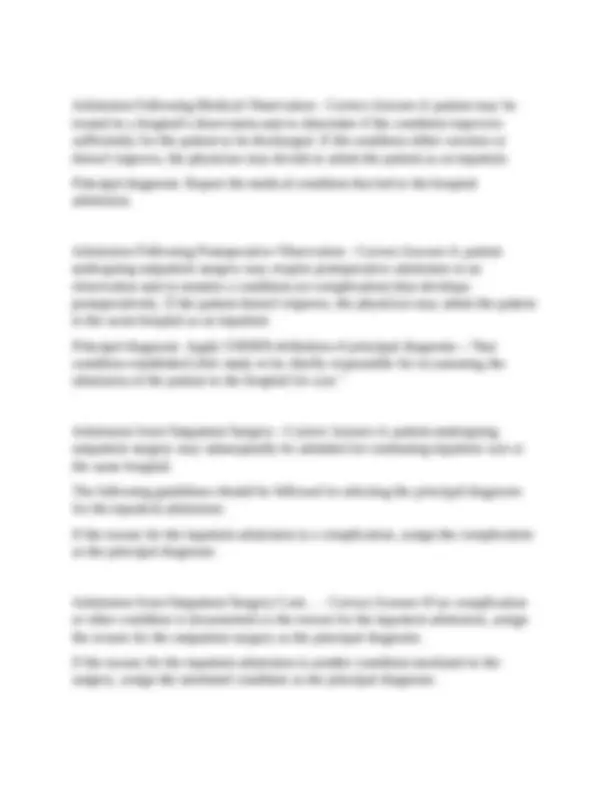
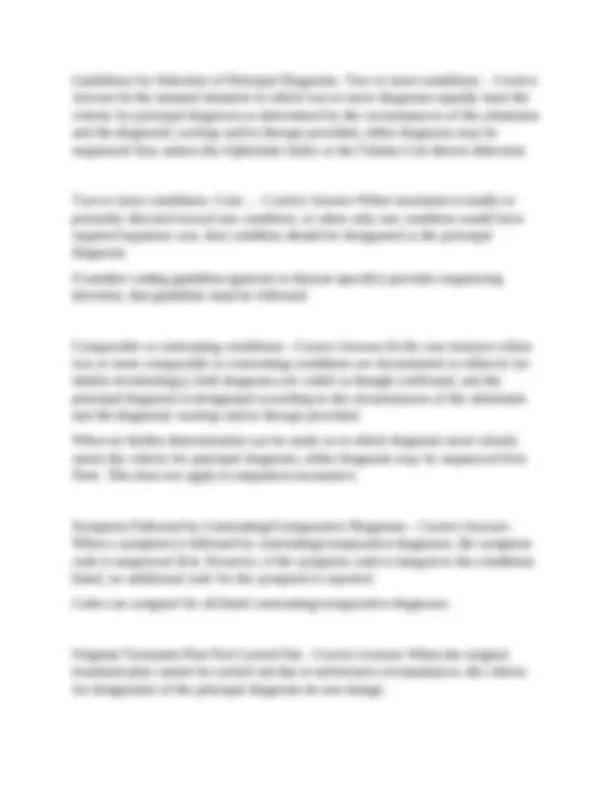
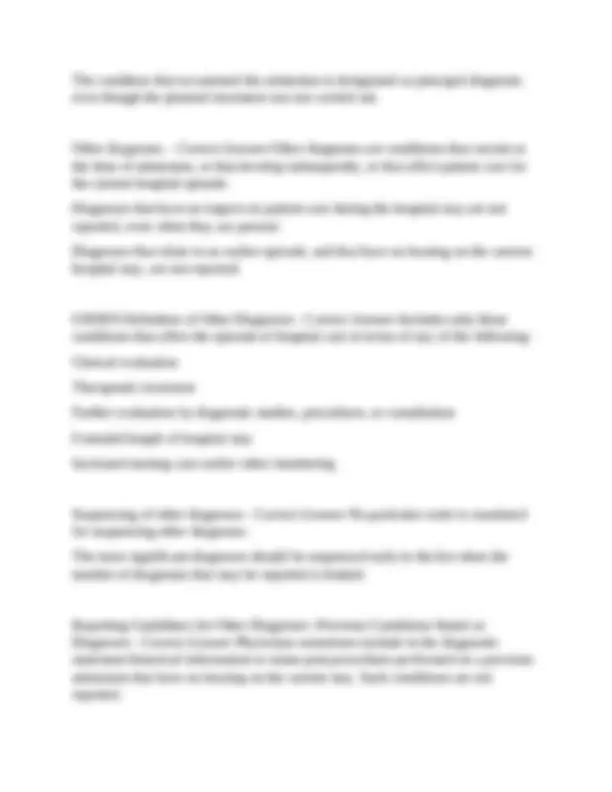
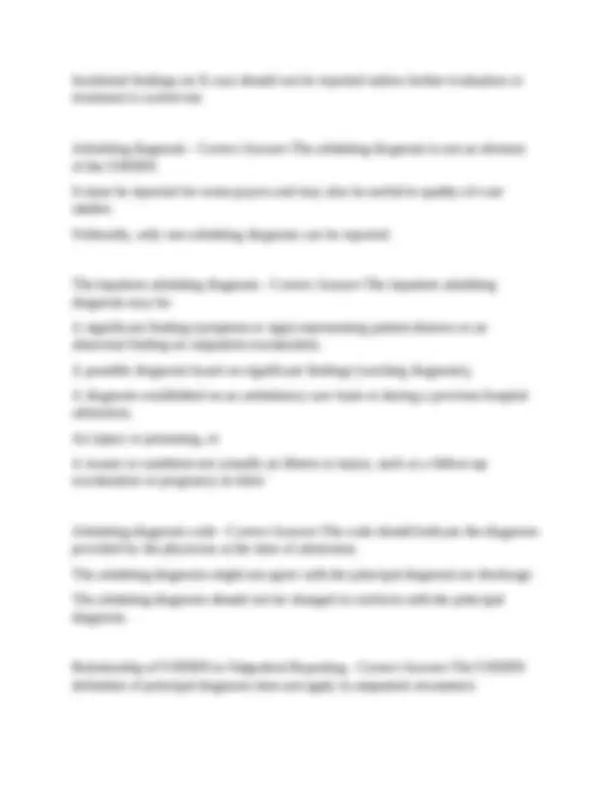
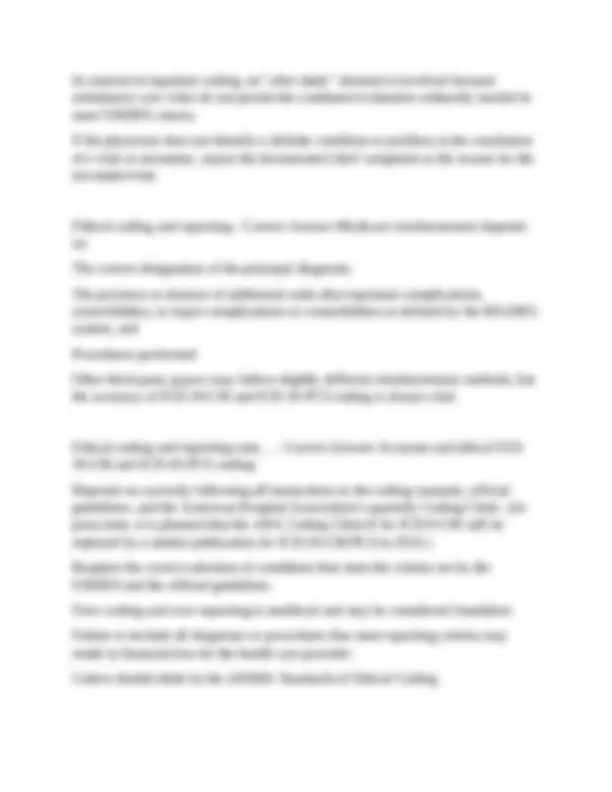
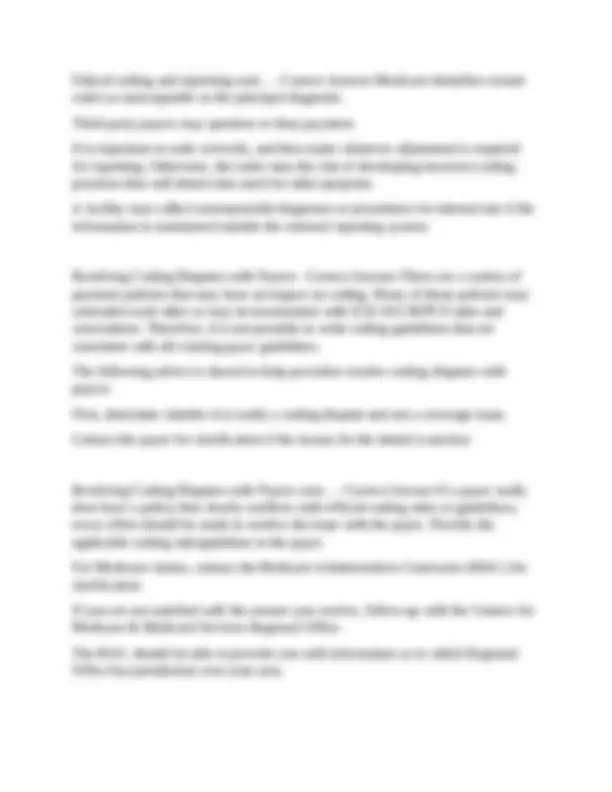


Study with the several resources on Docsity

Earn points by helping other students or get them with a premium plan


Prepare for your exams
Study with the several resources on Docsity

Earn points to download
Earn points by helping other students or get them with a premium plan
Community
Ask the community for help and clear up your study doubts
Discover the best universities in your country according to Docsity users
Free resources
Download our free guides on studying techniques, anxiety management strategies, and thesis advice from Docsity tutors
Uniform Hospital Discharge Data Set (UHDDS) questions with correct answers
Typology: Exams
1 / 11

This page cannot be seen from the preview
Don't miss anything!







Uniform Hospital Discharge Data Set (UHDDS) - Correct Answer-Used for reporting inpatient data in acute care, short-term care, and long-term care hospitals. Minimum set of items based on standard definitions to provide consistent data for multiple users. Required for reporting Medicare and Medicaid patients. Many other health care payers also use most of the UHDDS for the uniform billing system. UHDDS requiered data item - Correct Answer-The UHDDS requires the following items: Principal diagnosis, Other diagnoses that have significance for the specific hospital episode, and All significant procedures. Other items of general information regarding the patient and the specific episode of care: Age, sex, and race of the patient, Expected payer, and Hospital's identification UHDDS application - Correct Answer-Originally developed for hospital reporting of inpatient data elements. Application of definitions expanded to all non-outpatient settings. Definitions and guidelines for selection of principal diagnosis and other (secondary) diagnoses apply to: Acute care short-term hospitals,
Long-term care hospitals, Psychiatric hospitals, Home health agencies, Rehabilitation facilities, Nursing homes, and other settings. Principal Diagnosis- Definition and Importance - Correct Answer-Definition: The condition established after study to be chiefly responsible for admission of the patient to the hospital. Importance of correct selection: Significant in cost comparisons, in care analysis, and in utilization review. Crucial for reimbursement because many third-party payers (including Medicare) base reimbursement primarily on principal diagnosis. Principal Diagnosis and " After study" - Correct Answer-The principal diagnosis is NOT the admitting diagnosis, but the diagnosis found after workup or even after surgery that proves to be the reason for admission. The principal diagnosis is ordinarily listed first in the physician's diagnostic statement, but this is not always the case. Always review the entire medical record to determine the condition that should be designated as the principal diagnosis. Selection of Principal Diagnosis - Correct Answer-The circumstances of inpatient admission always govern the selection of the principal diagnosis. Coding directives in the ICD-10-CM classification take precedence over all other guidelines. Consistent, complete documentation in the medical record is important. Without such documentation, the application of all coding guidelines is a difficult, if not impossible, task.
Guidelines for Selection of Principal Diagnosis- Two or more conditions. - Correct Answer-In the unusual situation in which two or more diagnoses equally meet the criteria for principal diagnosis as determined by the circumstances of the admission and the diagnostic workup and/or therapy provided, either diagnosis may be sequenced first, unless the Alphabetic Index or the Tabular List directs otherwise Two or more conditions- Cont... - Correct Answer-When treatment is totally or primarily directed toward one condition, or when only one condition would have required inpatient care, that condition should be designated as the principal diagnosis. If another coding guideline (general or disease-specific) provides sequencing direction, that guideline must be followed. Comparable or contrasting conditions - Correct Answer-In the rare instance where two or more comparable or contrasting conditions are documented as either/or (or similar terminology), both diagnoses are coded as though confirmed, and the principal diagnosis is designated according to the circumstances of the admission and the diagnostic workup and/or therapy provided. When no further determination can be made as to which diagnosis more closely meets the criteria for principal diagnosis, either diagnosis may be sequenced first. Note: This does not apply to outpatient encounters. Symptom Followed by Contrasting/Comparative Diagnoses - Correct Answer- When a symptom is followed by contrasting/comparative diagnoses, the symptom code is sequenced first. However, if the symptom code is integral to the conditions listed, no additional code for the symptom is reported. Codes are assigned for all listed contrasting/comparative diagnoses. Original Treatment Plan Not Carried Out - Correct Answer-When the original treatment plan cannot be carried out due to unforeseen circumstances, the criteria for designation of the principal diagnosis do not change.
The condition that occasioned the admission is designated as principal diagnosis even though the planned treatment was not carried out. Other diagnoses. - Correct Answer-Other diagnoses are conditions that coexist at the time of admission, or that develop subsequently, or that affect patient care for the current hospital episode. Diagnoses that have no impact on patient care during the hospital stay are not reported, even when they are present. Diagnoses that relate to an earlier episode, and that have no bearing on the current hospital stay, are not reported. UHDDS Definition of Other Diagnoses - Correct Answer-Includes only those conditions that affect the episode of hospital care in terms of any of the following: Clinical evaluation Therapeutic treatment Further evaluation by diagnostic studies, procedures, or consultation Extended length of hospital stay Increased nursing care and/or other monitoring Sequencing of other diagnoses - Correct Answer-No particular order is mandated for sequencing other diagnoses. The more significant diagnoses should be sequenced early in the list when the number of diagnoses that may be reported is limited. Reporting Guidelines for Other Diagnoses -Previous Conditions Stated as Diagnoses - Correct Answer-Physicians sometimes include in the diagnostic statement historical information or status post procedures performed on a previous admission that have no bearing on the current stay. Such conditions are not reported.
Example: A patient was admitted with nausea and vomiting due to infectious gastroenteritis. Nausea and vomiting are common symptoms of infectious gastroenteritis and are therefore not reported. Example: A patient was seen in the physician's office complaining of urinary frequency and was diagnosed with benign prostatic hypertrophy. Although urinary frequency is a symptom of BPH, both conditions are reported because of the instructional note in the Tabular List under code 600.01. Conditions that are not an integral part of a disease process - Correct Answer- Conditions that are not an integral part of a disease process should be coded when present. Example: A 5-year-old boy was admitted with a 104-degree fever associated with acute pneumonia. During the first 24 hours, the patient also experienced convulsions due to the high fever. Both the pneumonia and the convulsions are reported because convulsions are not routinely associated with pneumonia. Fever is commonly associated with pneumonia, however, and no code is assigned for it. Abnormal findings - Correct Answer-Categories R70-R97 for nonspecific abnormal findings (laboratory, radiology, pathology, and other diagnostic results) should be assigned only when the physician has not been able to arrive at a related diagnosis but indicates that the abnormal finding is considered to be clinically significant by listing it in the diagnostic statement. This differs from outpatient setting coding of diagnostic tests interpreted by a physician. Codes should never be assigned on the basis of an abnormal finding alone. Abnormal findings cont.... - Correct Answer-When findings are clearly outside the normal range and the physician has ordered other tests to evaluate the condition or has prescribed treatment without documenting an associated diagnosis, it is appropriate to ask the physician whether a diagnosis should be added or whether the abnormal finding should be listed in the diagnostic statement.
Incidental findings on X-rays should not be reported unless further evaluation or treatment is carried out. Admitting diagnosis - Correct Answer-The admitting diagnosis is not an element of the UHDDS. It must be reported for some payers and may also be useful in quality-of-care studies. Ordinarily, only one admitting diagnosis can be reported. The inpatient admitting diagnosis - Correct Answer-The inpatient admitting diagnosis may be: A significant finding (symptom or sign) representing patient distress or an abnormal finding on outpatient examination, A possible diagnosis based on significant findings (working diagnosis), A diagnosis established on an ambulatory care basis or during a previous hospital admission, An injury or poisoning, or A reason or condition not actually an illness or injury, such as a follow-up examination or pregnancy in labor Admitting diagnosis code - Correct Answer-The code should indicate the diagnosis provided by the physician at the time of admission. The admitting diagnosis might not agree with the principal diagnosis on discharge. The admitting diagnosis should not be changed to conform with the principal diagnosis. Relationship of UHDDS to Outpatient Reporting - Correct Answer-The UHDDS definition of principal diagnosis does not apply to outpatient encounters.
Ethical coding and reporting cont... - Correct Answer-Medicare identifies certain codes as unacceptable as the principal diagnosis. Third-party payers may question or deny payment. It is important to code correctly, and then make whatever adjustment is required for reporting. Otherwise, the coder runs the risk of developing incorrect coding practices that will distort data used for other purposes. A facility may collect nonreportable diagnoses or procedures for internal use if the information is maintained outside the external reporting system. Resolving Coding Disputes with Payers - Correct Answer-There are a variety of payment policies that may have an impact on coding. Many of those policies may contradict each other or may be inconsistent with ICD-10-CM/PCS rules and conventions. Therefore, it is not possible to write coding guidelines that are consistent with all existing payer guidelines. The following advice is shared to help providers resolve coding disputes with payers: First, determine whether it is really a coding dispute and not a coverage issue. Contact the payer for clarification if the reason for the denial is unclear. Resolving Coding Disputes with Payers cont... - Correct Answer-If a payer really does have a policy that clearly conflicts with official coding rules or guidelines, every effort should be made to resolve the issue with the payer. Provide the applicable coding rule/guideline to the payer. For Medicare claims, contact the Medicare Administrative Contractor (MAC) for clarification. If you are not satisfied with the answer you receive, follow up with the Centers for Medicare & Medicaid Services Regional Office. The MAC should be able to provide you with information as to which Regional Office has jurisdiction over your area.
Resolving Coding Disputes with Payers cont... - Correct Answer-If a payer refuses to change its policy, obtain the payer requirements in writing. If the payer refuses to provide its policy in writing, document all discussions with the payer, including dates and the names of individuals involved in the discussion. Confirm the existence of the policy with the payer's supervisory personnel. Keep a permanent file of the documentation obtained regarding payer coding policies. It may come in handy in the event of an audit.